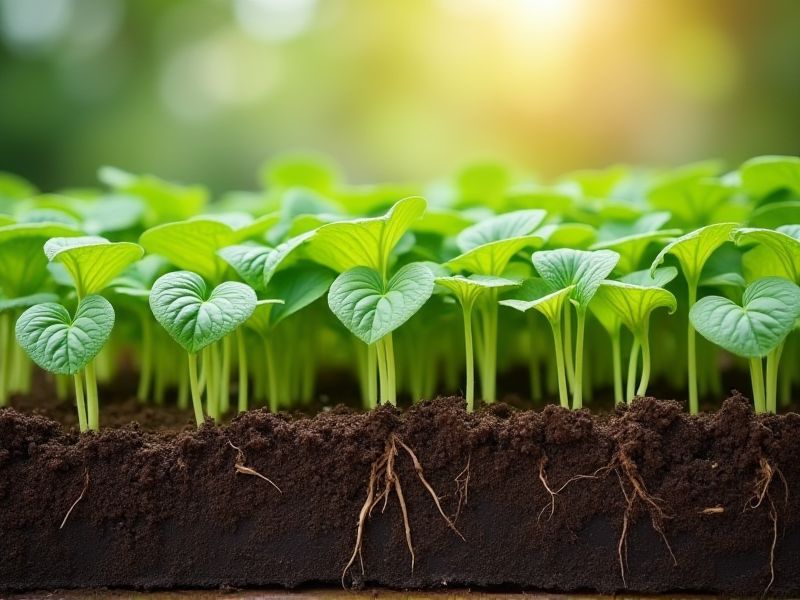
Fast-rooting plants, such as vetiver grass and certain leguminous species, are crucial for soil stabilization in various ecosystems. Their extensive root systems penetrate deeply into the ground, preventing soil erosion caused by wind and water. By binding the soil particles together, these plants enhance soil structure, thereby improving its overall health and fertility. You can find these species beneficial in agricultural settings, urban landscaping, and reforestation projects, where they not only stabilize but also promote biodiversity. Implementing fast-rooting plants in your soil management practices can significantly enhance land resilience against climate change impacts.
List of some Fast-rooting plants that stabilize soils
- Willow (Salix spp.)
- Poplar (Populus spp.)
- Bamboo (Bambusoideae spp.)
- Alder (Alnus spp.)
- Dogwood (Cornus spp.)
- Vetiver (Chrysopogon zizanioides)
- Reed Canary Grass (Phalaris arundinacea)
- Switchgrass (Panicum virgatum)
- Saltbush (Atriplex spp.)
- Lovegrass (Eragrostis spp.)
Important things about Fast-rooting plants that stabilize soils
Enhance Soil Structure
Fast-rooting plants, such as clover and ryegrass, play a crucial role in enhancing soil structure and stabilization. These plants develop extensive root systems that penetrate the topsoil, creating channels for air and water to infiltrate effectively, which improves soil porosity. By binding soil particles together, their roots reduce erosion and prevent sediment loss, making them ideal for slopes and disturbed land. Incorporating these fast-rooting plants into your landscaping or agricultural practices can significantly benefit soil health and promote a more resilient ecosystem.
Improve Water Retention
Fast-rooting plants play a pivotal role in enhancing water retention and stabilizing soils, making them invaluable for sustainable agriculture and erosion control. Species such as vetiver grass and deep-rooted legumes develop extensive root systems that not only anchor the soil but also improve its structure, allowing for better moisture retention. By incorporating these plants into your landscape or farming practices, you can significantly reduce surface runoff and promote healthier ecosystems. Their rapid growth and adaptability further contribute to improved soil health, fostering a more resilient environment against climate variability.
Reduce Erosion
Fast-rooting plants, such as grasses and certain shrubs, play a crucial role in soil stabilization and erosion control. Their extensive root systems penetrate deeply into the soil, creating a natural barrier that holds the soil in place and reduces the risk of erosion caused by wind and water. By increasing soil cohesion, these plants improve the soil structure and promote moisture retention, contributing to healthier ecosystems. Incorporating fast-rooting species in landscaping or agricultural practices can significantly enhance soil stability and prevent degradation in vulnerable areas.
Promote Biodiversity
Fast-rooting plants play a crucial role in promoting biodiversity and stabilizing soils effectively. These plants, such as willow, poplar, and certain grass species, establish deep root systems rapidly, which prevents erosion and supports soil structure. By improving soil health, they enhance water retention and nutrient cycling, benefiting surrounding flora and fauna. You can contribute to biodiversity by incorporating these fast-rooting species in your landscape, creating a more resilient ecosystem.
Increase Organic Matter
Fast-rooting plants, such as grasses and legumes, play a crucial role in enhancing soil stability by increasing organic matter content. These species develop extensive root systems that not only anchor the soil but also improve its structure, promoting better water retention and nutrient availability. As these plants die and decompose, they contribute organic matter, which enriches the soil, supports beneficial microorganisms, and improves overall soil health. Incorporating fast-rooting plants into your landscaping or agricultural practices can significantly mitigate erosion and enhance soil resilience.
Support Nutrient Cycling
Fast-rooting plants play a crucial role in nutrient cycling by rapidly establishing extensive root systems that enhance soil stability. Their ability to anchor the soil prevents erosion and contributes organic matter through leaf litter, enriching the nutrient profile of the ecosystem. These plants, such as perennial grasses and certain legumes, promote beneficial microbial activity, which further aids in breaking down organic material and enhancing nutrient availability. By incorporating fast-rooting species into your landscape, you can foster healthier soils while supporting a dynamic nutrient cycling process.
Adapt To Various Climates
Fast-rooting plants, such as vetiver grass and certain species of legumes, play a crucial role in soil stabilization across diverse climates. These plants develop extensive root systems that penetrate deep into the soil, reducing erosion and enhancing water retention. In arid regions, species like agave and prickly pear cactus thrive, providing stability and moisture retention. Meanwhile, in temperate zones, fast-growing cover crops like clover not only prevent soil degradation but also improve soil fertility, demonstrating their adaptability and ecological significance.
Provide Habitat For Wildlife
Fast-rooting plants, such as certain species of grasses and herbs, play a crucial role in stabilizing soils and providing habitat for wildlife. These plants develop extensive root systems that anchor the soil, preventing erosion and promoting soil health. By enhancing soil structure, they create a favorable environment for various organisms, including insects and small mammals, which rely on these plants for food and shelter. Incorporating fast-rooting plants into landscaping or restoration projects can significantly increase biodiversity while supporting local ecosystems.
Require Low Maintenance
Fast-rooting plants such as native grasses, clover, and certain legumes play a crucial role in stabilizing soils and preventing erosion. These species establish quickly, creating a robust root system that enhances soil structure and increases water retention. Their ability to grow in various conditions makes them ideal for restoration projects and landscapes prone to erosion. Incorporating these resilient plants into your garden or landscape not only reduces maintenance but also contributes to local biodiversity and soil health.
Accelerate Soil Recovery
Fast-rooting plants such as willows, poplars, and specific grasses play a pivotal role in accelerating soil recovery and stabilizing erosion-prone areas. Their extensive root systems not only anchor soil but also promote moisture retention, thereby improving soil structure and fertility. You can enhance your garden or landscape by incorporating these resilient species, which are particularly effective in disturbed sites where soil quality needs restoration. Ultimately, utilizing fast-rooting plants aids in preventing further degradation and fosters a healthier ecosystem.
